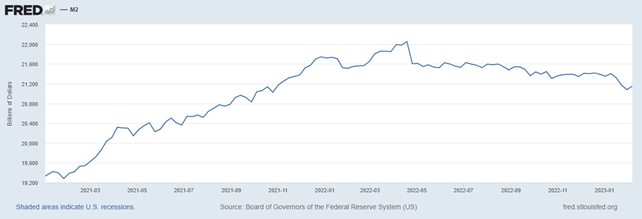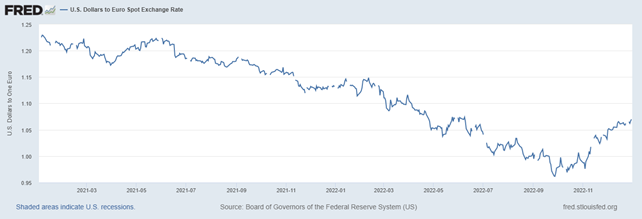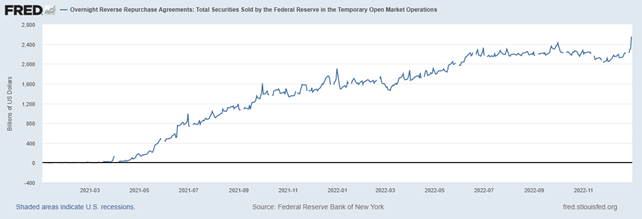The collapse of Swiss banking giant Credit Suisse recently was a catastrophe long in the making. A quick perusal of the bank’s financial statements from recent years shows that we’re dealing with something analogous to a classic bank run. Credit Suisse’s pool of liquid assets declined more than 50 percent from 2021 to 2022, mostly in October 2022, from CHF 229.9 billion to CHF 118.5 billion as depositors withdrew their money. Despite the timing, however, the fall of Credit Suisse had little directly to do with the collapse of Silicon Valley Bank and a lot to do with the contraction of the international monetary system.
The Contractionary Fed
As pointed out last year, the Federal Reserve has long pursued a deflationary policy. This may come as a surprise, since official inflation numbers are still elevated and Federal Reserve officials have continued (until very recently, at least) to pronounce their determination to bring down inflation. However, if we look at changes in the money supply, and especially changes in that part of it the Fed directly controls, it becomes apparent that sizeable deflation has been occurring. The US M2 money supply had been slightly falling since April 2022 and in total declined by about USD 900 billion until February 2023 (figure 1), but the real contraction is significantly larger.
Figure 1: US M2 money supply, January 2021–March 2023
To see this, we only need to look at the Fed’s balance sheet, specifically at reverse repurchase (repo) agreements (which is where the Fed sells an asset and promises to buy it back the following day at a slightly higher price determined by the repo rate). As I pointed out last year, by accumulating reverse repos, the Fed is effectively sterilizing bank reserves. Banks and financial institutions move their cash into repos at the Fed, where they earn a cool, risk-free 4.80 percent. As a result, the reserves in the financial system have fallen, since repos do not serve as reserve balances for the commercial banking system. Reverse repo operations have partly served to soak up reserves added to the system during the corona inflation, but it is important to note which financial institutions have access to the Fed’s reverse repo operations.
Not all banks have access—in addition to the primary dealers, only accepted reverse repo counterparties can conduct business with the New York Fed. A quick look at these lists reveals them to be a veritable who’s who of Wall Street and international investment banks, from old names like J.P. Morgan and Goldman Sachs to more recently famous Blackrock and Vanguard to Swiss banks Credit Suisse and UBS. It is especially the international aspect that is of interest here. It is the markets that these international banks operate in that have been drained of dollars due to Fed deflation—and above all, that means the Eurodollar system.
Eurodollars and the Fed
Eurodollars are simply dollar deposits originating outside the United States and thus not subject to US regulations. Since the 1960s they have played an increasing role in the international financial system. The Eurodollar system is not, however, totally detached from the American banking system; above all, it is not detached from the Federal Reserve. The Eurodollar banks, like all modern banks, operate on a fractional reserve basis.
Thus, if reserves are cheap and plentiful, they expand; and if reserves become expensive and scarce, they contract. The ultimate supplier of reserves is the Federal Reserve—either directly, through related international investment banks or indirectly, through US banks that supply credit to international borrowers. Thus, while the expansion of Fed reverse repos seems to have had only a belated and weak effect on the domestic money supply, the Eurodollar institutions experienced a significant contraction of reserves.
Figure 2: US dollars to euro spot exchange rate, January 2021–January 2023
Unfortunately, we have no direct knowledge of the number of Eurodollars in existence, but the rapid appreciation of the dollar throughout 2021 and 2022 suggests that there was a substantial contraction of the Eurodollar supply (figure 2). This contraction also compares well with changes in reverse repos: the dollar appreciated continuously to almost 96 cents per euro in late September 2022, only to depreciate rapidly thereafter, while reverse repos reached a peak of USD 2.4 trillion on Friday, September 30, 2022, and have fallen significantly since (figure 3; it should be noted that there is a seasonal spike in reverse repos at quarter end, but the trend is clear). The Fed’s contraction therefore really ended back in October 2022—after that, no talk of tightening was connected to the reality in the international dollar market.
Figure 3: Overnight Fed reverse repos, January 2021–January 2023
Back to Bern
It is surely significant that the change in Fed policy came about at exactly the time that Credit Suisse felt the squeeze, in October 2022. Now, this change in policy was not necessarily entirely driven by the Fed, since credit contraction would drive up interest rates in the market and thereby make it attractive to move from reverse repurchases to expansionary private lending anyway. As credit tightened for Credit Suisse, the Swiss bankers would be willing to pay dearly for short-term loans to fund the outflow of deposits and avoid illiquidity and bankruptcy. However, that can only explain a short-run change in the flow of liquidity. The turn to loose money in October, then, was a deliberate policy change, aimed at propping up the Eurodollar market.
One can speculate about what prompted the Feds to first drain the Eurodollar system and then reverse the decision when the first bank threatened to collapse. It is always a live option that these people did not, in fact, know what they were doing—but it strains credulity that the Cantillionaires, those bankers and financiers close to the central bank, whose wealth and power depend on access to the Fed and the privileges supporting the broader fiat money system, did not realize the implications of the policy changes.
According to the central bank’s own explainer, raising the repo rate (and thus attracting more reverse repos) is simply a necessary part of raising the interest rate on domestic reserves and thereby preventing a domestic overexpansion of the money supply. Since the Fed risked losing all credibility if it did nothing in the face of the high inflation and monetary overhang from the corona policies, Chairman Jerome Powell and his fellow rate setters may simply have felt forced. Once their primary clients, the Cantillionaires, really felt the heat, however, the Fed quickly changed gears.
Central Bank to the World?
In the aftermath of the collapse of Credit Suisse, still in the process of being taken over by UBS, on March 19 the Federal Reserve and the main central banks of the Western world reactivated their liquidity swap lines. These swaps lines were a key tool in “saving” the international system after the great financial crisis and will play a similar role today: non-US central banks will borrow dollars from the Fed using their own currencies as collateral.
Say the Swiss National Bank (SNB) wants to supply Swiss banks with dollar liquidity. In a swap with the Fed, it first buys a dollar deposit at the Fed in exchange for a Swiss franc–denominated deposit at the SNB. The SNB can then use the dollars to supply liquidity to the Swiss financial system. To close the swap, the SNB sells the dollar deposit back to the Federal Reserve against the Swiss franc deposit. The exchange rate in this transaction is frozen; the Swiss National Bank only has to pay a small amount of interest on the loan. However, the swap is also an inflationary instrument: money is newly created to be used in these swaps—after all, that’s all a central bank can do.
A second important inflationary policy that the Fed has reactivated is the Foreign and International Monetary Authorities (FIMA) Repo Facility. Here central banks can borrow from the Fed using US Treasurys as collateral. While the focus in the press has been on the liquidity swap lines, the real action so far has been here: the supply of repos to foreign official institutions has expanded from zero to USD 60 billion in the week ended Wednesday, March 22. This looks so far to be a limited, one-off liquidity support—the coming weeks will show how many dollars the Fed will inject into the global dollar system.
It may sound like the Federal Reserve is now engaged in an altruistic quest to save the global financial system, and that is the stated intention. But it is far from altruistic. The Eurodollar system and the rest of the central bank–sponsored global financial system benefit the Fed’s real patrons among the Cantillionaires, who are placed in a position of privilege as bankers to the world. If the Eurodollar system collapsed, the Fed would have the most to lose. After all, any currency could serve as the global trade currency; the global use of the dollar and the Eurodollar system supported by the Fed and Western central banks are not necessary. However, he seigniorage the US earns on the global use of the dollar funds the US’s permanent balance-of-payments deficit: dollars and debt are exported in exchange for real goods and services, while Americans buy up foreign assets at a discount. Barry Eichengreen estimated that the US pays 2–3 percentage points less on its foreign liabilities than it earns on its foreign investments.
In fact, the global financial system resembles the old Bretton Woods system. Bretton Woods led to a great wealth transfer from Europe to the US—to the spoliation of Europe, as Jacques Rueff called it. The modern, dollar-based financial system leads to similar benefits for the US economy and for US-based financiers. Americans can consume more and the US government can spend more because foreigners are forced or induced to use the US dollar. The Federal Reserve, now and always, is simply acting in the narrow interests of its sponsors. These interests dictate policy. Fed tightening was probably seen as necessary to maintain the legitimacy of the system, but once serious problems emerged back in October, the Fed quickly changed gears to easing. That Credit Suisse fell despite this change, and that we now see much more drastic interventions in the financial system, only shows the limitations of central bank power. Inflation can only distort reality for a while, benefiting some and hurting others, it cannot permanently lead to general prosperity—a crisis must come.
Full story here Are you the author? Previous post See more for Next postTags: Featured,newsletter
























